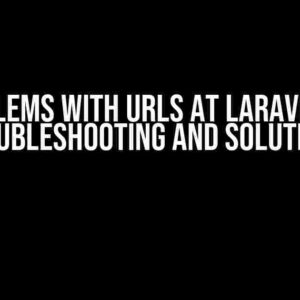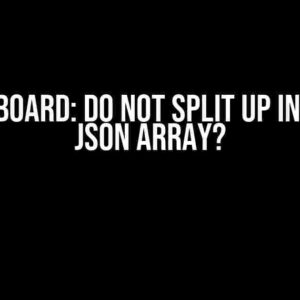If you’re reading this, chances are you’ve stumbled upon a pesky Sonar error while working with iframes and event listeners. Don’t worry, we’ve got you covered! In this comprehensive guide, we’ll delve into the world of Sonar errors, explain what’s causing this particular issue, and provide step-by-step solutions to get you back on track.
What is Sonar?
Sonar is a code analysis tool that helps developers identify and fix bugs, vulnerabilities, and coding standards issues in their codebase. It’s an essential tool for maintaining high-quality code and ensuring your application’s performance, security, and reliability.
The Error: Non-interactive Elements Should Not Be Assigned Mouse or Keyboard Event Listeners
This Sonar error occurs when you assign mouse or keyboard event listeners to non-interactive elements within an iframe. But what exactly are non-interactive elements, and why is Sonar complaining about them?
What are Non-interactive Elements?
Non-interactive elements are HTML elements that cannot receive focus or be interacted with by the user. Examples of non-interactive elements include:
- <p>
- <span>
- <div> (without a tabindex attribute)
- <img>
- <br>
- <hr>
These elements are not meant to be interacted with by the user and should not have event listeners assigned to them.
Why is Sonar Complaining About Non-interactive Elements?
Sonar is complaining about non-interactive elements because assigning event listeners to them can lead to:
- Inaccessible content: Users may not be able to interact with the element, making it inaccessible.
- Performance issues: Event listeners can cause unnecessary overhead and slow down your application.
- Security risks: Malicious actors can exploit event listeners to inject malicious code or steal user data.
Solutions to the Sonar Error
Now that we’ve covered the what and why, let’s dive into the solutions to this Sonar error. Here are some step-by-step instructions to help you resolve the issue:
Solution 1: Remove Unnecessary Event Listeners
Review your code and remove any unnecessary event listeners assigned to non-interactive elements within the iframe. Ask yourself:
- Is this event listener necessary for the functionality of the application?
- Can the event listener be reassigned to a more suitable element?
If the answer is no, remove the event listener.
Solution 2: Use tabindex to Make Elements Interactive
If you need to assign an event listener to an element within the iframe, make sure it’s an interactive element by adding a tabindex attribute. For example:
<div tabindex="0"></div>This makes the <div> element focusable and interactive, allowing you to assign event listeners to it.
Solution 3: Use a Wrapper Element with tabindex
If you can’t modify the non-interactive element, wrap it with a container element that has a tabindex attribute. For example:
<div tabindex="0"><p>This element is now interactive!</p></div>This makes the container <div> element interactive, allowing you to assign event listeners to it instead of the non-interactive <p> element.
Solution 4: Use a JavaScript Library or Framework to Help You Out
If you’re using a JavaScript library or framework like jQuery or React, you can leverage their built-in functionality to handle event listeners and accessibility. For example, jQuery’s focusin event can help you detect when an element is focusable.
$( '.interactive-element' ).on( 'focusin', function() {
// Add your event listener logic here
});React, on the other hand, provides a tabIndex prop to make elements interactive.
<div tabIndex={0}></div>Remember to always follow the official documentation and best practices for your chosen library or framework.
Best Practices for iframe and Event Listeners
To avoid Sonar errors and ensure your application is accessible and performant, follow these best practices when working with iframes and event listeners:
-
Only assign event listeners to interactive elements within the iframe.
-
Use tabindex to make non-interactive elements focusable and interactive.
-
Wrap non-interactive elements with a container element that has a tabindex attribute.
-
Leverage JavaScript libraries or frameworks to handle event listeners and accessibility.
-
Regularly review and test your code for accessibility and performance issues.
Conclusion
In this article, we’ve covered the Sonar error “Non-interactive elements should not be assigned mouse or keyboard event listeners” and provided step-by-step solutions to resolve the issue. By following these best practices and solutions, you’ll be able to create a more accessible, performant, and secure application that meets the latest web development standards.
Remember, Sonar errors are not just pesky warnings – they’re opportunities to refine your code and provide a better user experience. Happy coding!
| Sonar Error | Solution |
|---|---|
| Non-interactive elements should not be assigned mouse or keyboard event listeners | Remove unnecessary event listeners, use tabindex, wrap elements with a container, or leverage JavaScript libraries/frameworks |
We hope this comprehensive guide has helped you tackle the Sonar error on iframe and event listeners. If you have any questions or need further assistance, please leave a comment below!
Frequently Asked Question
Welcome to our FAQs section, where we answer the most burning questions about sonar errors on iframes!
What does the sonar error “Non-interactive elements should not be assigned mouse or keyboard event listeners” mean?
This error message pops up when you’ve assigned event listeners to HTML elements that are not meant to be interactive. Think of it like trying to click on a piece of text – it’s not meant to be clicked, right? Sonar is just reminding you to keep those interactions reserved for the right elements, like buttons or links!
Why is this sonar error important to fix?
Fixing this error is crucial for two reasons: accessibility and performance. By removing unnecessary event listeners, you’re making your website more accessible to users with disabilities, who might rely on assistive technologies to navigate. Plus, it improves page performance by reducing the number of event listeners, making your site faster and more enjoyable for everyone!
How do I identify the non-interactive elements with assigned event listeners?
Easy peasy! Just review your HTML code and check for any event listeners (like onclick or onmouseover) assigned to elements that shouldn’t be interactive, such as `
`, ``, or ``. You can also use the browser’s developer tools to inspect the elements and see which ones have event listeners attached.
Can I just ignore this sonar error and move on?
We wouldn’t recommend it! Ignoring this error might not cause immediate issues, but it can lead to problems down the line. By fixing it, you’re ensuring a better user experience, improved accessibility, and a more maintainable codebase. So, take a few minutes to address the issue and reap the benefits in the long run!
Are there any resources available to help me fix this sonar error?
Absolutely! You can start by checking out the official documentation for your framework or library to see if they have any guidelines for handling event listeners. Additionally, there are many online resources and tutorials available that can provide step-by-step guidance on fixing this error. And, of course, you can always reach out to our community or a frontend developer for assistance!






